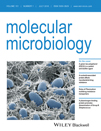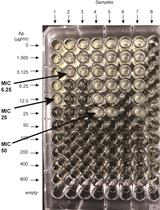- EN - English
- CN - 中文
Purification of N-coronafacoyl Phytotoxins from Streptomyces scabies
疮痂病链霉菌N-coronafacoyl植物毒素的纯化
发布: 2017年04月05日第7卷第7期 DOI: 10.21769/BioProtoc.2214 浏览次数: 8071
评审: Valentine V TrotterRosario Gomez-GarciaAnonymous reviewer(s)

相关实验方案
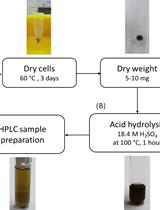
酸水解-高效液相色谱法测定集胞藻PCC 6803中聚3-羟基丁酸酯的含量
Janine Kaewbai-ngam [...] Tanakarn Monshupanee
2023年08月20日 1375 阅读
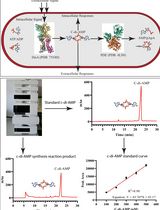
基于高效液相色谱法的史氏分枝杆菌DisA环二腺苷酸(C-di-AMP)合成酶活性研究
Avisek Mahapa [...] Dipankar Chatterji
2024年12月20日 1193 阅读
Abstract
This procedure is used for large-scale purification of N-coronafacoyl phytotoxins that are produced by the potato common scab pathogen Streptomyces scabies. The procedure employs organic extraction of S. scabies culture supernatants under alternating basic and acidic conditions in order to preferentially isolate the phytotoxin - containing carboxylic acid fraction of the supernatant. Preparative thin layer chromatography and semi-preparative reverse phase - high performance liquid chromatography are then used to further purify the individual N-coronafacoyl phytotoxins of interest.
Keywords: Streptomyces (链霉菌)Background
Potato common scab is an economically important crop disease that is caused by Gram-positive, filamentous, soil bacteria from the genus Streptomyces. The first described and best characterized scab - causing Streptomyces spp. is Streptomyces scabies (syn. S. scabiei), which has a worldwide distribution (Bignell et al., 2010). Current control practices for common scab disease management include crop rotation, irrigation and soil fumigation; however, these strategies often fail, produce inconsistent results or are environmental unfriendly (Dees and Wanner, 2012). In order to develop better control strategies for the disease, we must first understand the molecular mechanisms used by S. scabies to infect the plant and to induce disease symptoms. Research has shown that the ability of S. scabies to cause disease is due to the production of virulence factors that play different roles during the infection process. Among the known or potential virulence factors that are produced by S. scabies is a family of plant toxins referred to as the N-coronafacoyl phytotoxins (also known as the COR-like metabolites), which resemble the plant hormone jasmonic acid and may function to suppress the plant immune response during pathogen infection (Bignell et al., 2010; Fyans et al., 2015). The primary coronafacoyl phytotoxin produced by S. scabies is N-coronafacoyl-L-isoleucine (CFA-L-Ile; Figure 1), which consists of the polyketide metabolite coronafacic acid linked via an amide bond to L-isoleucine. In addition, other N-coronafacoyl phytotoxins containing different isoleucine isomers or different amino acids (e.g., valine) can be produced in minor amounts (Fyans et al., 2015; Bown et al., 2016). 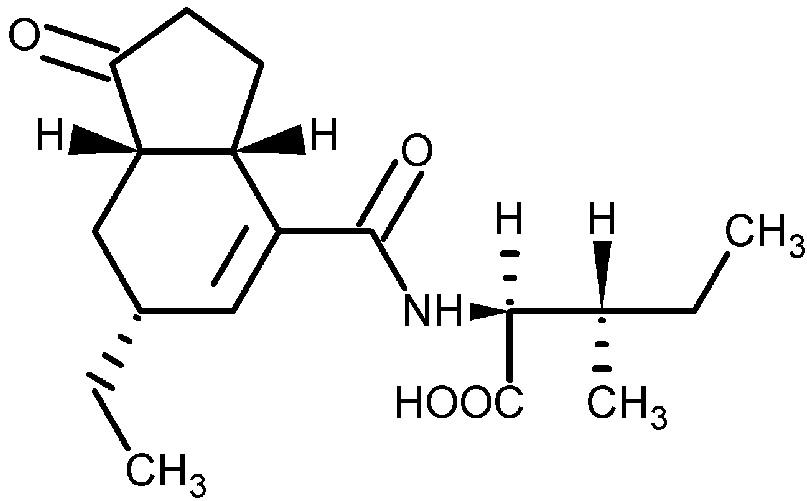
Figure 1. Structure of N-coronafacoyl-L-isoleucine (CFA-L-Ile) produced by Streptomyces scabies
The protocol described here was developed to isolate and purify N-coronafacoyl phytotoxins and their biosynthetic intermediates from large-scale cultures of S. scabies for purposes of structural and functional characterization. Previously, Fyans et al. (2015) described a protocol that was based in part on a published procedure for the isolation of the related N-coronafacoyl phytotoxin coronatine (COR) from cultures of the Gram-negative plant pathogenic bacterium Pseudomonas syringae (Palmer and Bender, 1993). As outlined by Fyans et al. (2015), strains of S. scabies are cultured in a soy flour mannitol broth (SFMB) medium, which promotes the production of the coronafacoyl phytotoxins, and then the culture supernatants are subjected to a two-step extraction with organic solvent under basic and acidic conditions in order to selectively isolate the phytotoxin - containing carboxylic acid fraction of the culture supernatants. The phytotoxins are then further purified using a combination of preparative thin layer chromatography (TLC) and semi-preparative reverse phase - high performance liquid chromatography (RP - HPLC). More recently, we described a modified version of this protocol in which we incorporated additional extraction steps using an aqueous solution of potassium bicarbonate (Bown et al., 2016). This modification was based on the procedure described by Mitchell and Frey (1986) for the isolation of P. syringae N-coronafacoyl phytotoxins, and we found that the incorporation of the additional extraction steps significantly improved the purity of the final S. scabies phytotoxin preparations. Moreover, we modified the organic solvent for the N-coronafacoyl phytotoxins by the addition of a small amount of acid, which significantly improved the solubility and yield of the purified phytotoxins for downstream structural and functional studies.
Here, we present the detailed step-by-step protocol for how we currently purify the S. scabies N-coronafacoyl phytotoxins in our laboratory.
Materials and Reagents
- pH test strips (VWR, BDH®, catalog number: BDH35309.606 )
- Hydrophilic polypropylene membrane filters, 47 mm diameter, 0.45 μm pore size (Pall, catalog number: 66548 )
- FisherbrandTM class B clear glass threaded vials with closures attached, 3.7 ml (Fisher Scientific, catalog number: 03-338A )
- Slip tip syringes, 1 ml (BD, catalog number: 309659 )
- PTFE membrane filters, 0.2 μm pore size, 6 mm diameter (VWR, catalog number: 28145-491 )
- WhatmanTM filter discs, 12.5 cm (Sigma-Aldrich, catalog number: WHA1113125 )
- Conical centrifuge tubes, 50 ml (Corning, Falcon®, catalog number: 352098 )
- Silica gel GF preparative TLC plates with pre-adsorbent zone, 20 x 20 cm, 1,000 μm (Analtech/iChromatography, catalog number: P32013 )
- DMSO mycelial freezer stock of S. scabies (Fyans et al., 2015)
- BactoTM tryptic soy broth medium (BD, BactoTM, catalog number: 211825 )
- Sodium hydroxide (NaOH) (Fisher Scientific, catalog number: BP359-212 )
- Chloroform, ACS grade (VWR, BDH®, catalog number: BDH1109 )
- Hydrochloric acid (HCl), ACS grade (Avantor® Performance Materials, catalog number: 638801 )
- Sodium sulfate anhydrous (Na2SO4), ACS grade (Fisher Scientific, catalog number: S421-500 )
- Ethylene glycol (VWR, BDH®, catalog number: BDH1125 )
- Potassium bicarbonate (KHCO3), ACS grade (Sigma-Aldrich, catalog number: 237205 )
- Methanol (MeOH), HPLC grade (Sigma-Aldrich, catalog number: 34860 )
- Formic acid, reagent grade (Sigma-Aldrich, catalog number: F0507 )
- HiPerSolv CHROMANOR® Acetonitrile (ACN) for HPLC (VWR, BDH®, catalog number: BDH83639.400 )
- Soy flour, defatted (MP Biomedicals, catalog number: 960024 )
- D-mannitol (AMRESCO, catalog number: 0122 )
- Ethyl acetate, ACS grade (Sigma-Aldrich, catalog number: 319902 )
- 2-propanol, HPLC grade (Fisher Scientific, catalog number: A451SK-4 )
- Acetic acid, ACS grade (Sigma-Aldrich, catalog number: 695092 )
- Water, HPLC grade (EMD Millipore, catalog number: WX0008-1 )
- Soy flour mannitol broth (SFMB) medium (see Recipes)
- Preparative TLC mobile phase (see Recipes)
Equipment
- Glass Erlenmeyer flask, 125 ml (Corning, PYREX®, catalog number: C4980125 )
- Glass Erlenmeyer flask, 4 L (Corning, PYREX®, catalog number: C49804L )
- Glass filter holder assembly with funnel, fritted base, stopper and clamp, 47 mm (EMD Millipore, catalog number: XX1004700 )
- NalgeneTM PPCO centrifuge bottles with sealing closure, 250 ml (Thermo Fisher Scientific, Thermo ScientificTM, catalog number: 31410250 )
- SorvalTM ST 16R benchtop refrigerated centrifuge (Thermo Fisher Scientific, Thermo ScientificTM, model: SorvalTM ST 16R , catalog number: BCT25)
- Innova® 42R refrigerated incubator shaker, orbit diameter 1.9 cm (Eppendorf, New BrunswickTM, model: Innova® 42R , catalog number: M1335-004)
- 2 L plastic container
- NalgeneTM TeflonTM FEP separatory funnel with closure, 2 L (Thermo Fisher Scientific, Thermo ScientificTM, catalog number: 4301-2000 )
- IKA® rotary evaporator system (IKA®, model: RV 10 digital V )
- VWR® refrigerated circulating bath with programmable temperature controller (VWR, model: VWR® Refrigerated Circulating Baths , catalog number: 89202-982)
- KIMAX® Squibb separatory funnel with PTFE stopcock and glass stopper, 125 ml (Kimble Chase Life Science and Research Products, catalog number: 29048F-125 )
- DryFast diaphragm vacuum pump (Welch Vacuum – Gardner Denver, catalog number: 2044 )
- Biohit mLINE® single-channel mechanical pipettor, 2-20 μl (VWR, catalog number: 47745-545 )
- Aldrich® rectangular TLC developing tank (Sigma-Aldrich, model: Z126195 )
- UV lamp with portable cabinet (Analtech/iChromatography, catalog number: A93-04 )
- Metal spatula
- Thermo ScientificTM dry block heater (Thermo Fisher Scientific, Thermo ScientificTM, catalog number: 88-860-021 )
- ZORBAX StableBond 80Å C18 semi-preparative HPLC column, 9.4 x 250 mm, 5 μm (Agilent Technologies, catalog number: 880975-202 )
- Chemical safety hood
- KIMAX® graduated filtering flask, 1 L (Kimble Chase Life Science and Research Products, catalog number: 27060-1000 )
- GeneMate vortex mixer (VWR, catalog number: 490000-094 )
- Agilent 1260 Infinity analytical-scale LC purification system with quaternary pump, autosampler, diode array detector and fraction collector (Agilent Technologies, model: 1260 Infinity )
Procedure
文章信息
版权信息
© 2017 The Authors; exclusive licensee Bio-protocol LLC.
如何引用
Bown, L. and Bignell, D. R. D. (2017). Purification of N-coronafacoyl Phytotoxins from Streptomyces scabies. Bio-protocol 7(7): e2214. DOI: 10.21769/BioProtoc.2214.
分类
微生物学 > 微生物生物化学 > 其它化合物
生物化学 > 其它化合物 > 植物毒素
您对这篇实验方法有问题吗?
在此处发布您的问题,我们将邀请本文作者来回答。同时,我们会将您的问题发布到Bio-protocol Exchange,以便寻求社区成员的帮助。
提问指南
+ 问题描述
写下详细的问题描述,包括所有有助于他人回答您问题的信息(例如实验过程、条件和相关图像等)。
Share
Bluesky
X
Copy link




